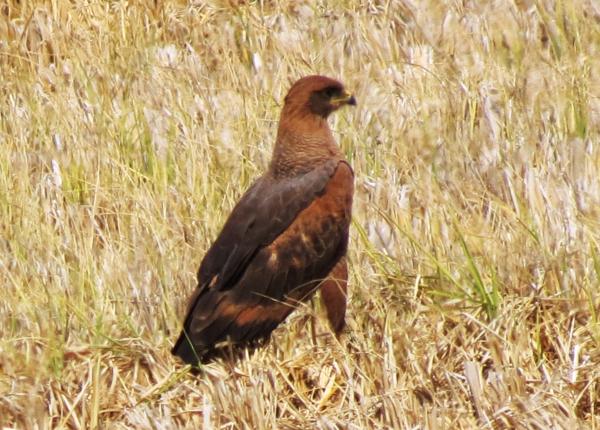Did You Know?
- The Savanna Hawk is also known as Red-winged Hawk, Rufous-headed Hawk, and Tawny Hawk
- Researchers documented this hawk pirating food from herons in Argentina
- Throughout most of its range, the Savanna Hawk is quite territorial, and remains in the same area all year round.
- This species was first documented in Costa Rica in 2008
How The Peregrine Fund is Helping
The Peregrine Fund is not working directly with Savanna Hawks, but our conservation efforts through habitat protection, education, and community outreach extend to all raptor species, including this hawk. We also supply literature to researchers from our avian research library, which helps scientists around the world gather and share important information on raptor conservation. And, we support the Neotropical Raptor Network that promotes raptor conservation by helping create collaboration and communication among conservationists in the region.
Where They Live
The Savanna Hawk is a Neotropical species found throughout much of South America, and into Central America, with its northernmost range being in Costa Rica, where it has only recently spread. True to its name, it prefers to spend its time in lowland savannas, and other open, more arid landscapes which often are dotted with scattered trees, and mangroves. This species can also be seen hunting or soaring near seashores, at forest edges, or even along roads and highways.
What They Do
The Savanna Hawk has been described as "lanky" due to its relatively long legs and neck. It is covered in rufous to cinnamon-colored feathers over much of its body. Its breast and belly are decorated with thin, dark lines. In flight, these hawk shows off the dark black edging along its primary and secondary feathers.
When in search of a Savanna Hawk, it is a good idea to scan fence posts, power lines, or even high mounds of dirt. These are all places that this beautiful hawk likes to perch. But don't forget to look on the ground too. It can spend quite a bit of time walking around, possibly in search of prey. Though this bird seems to be fond of spending time alone, once in a while it congregates in groups of 50 or more, especially when there is a grass fire, where prey can often be caught more easily.
Why They Need our Help
This species is quite common throughout most of its range. In fact, because this hawk prefers more open habitats, it appears that its population is actually expanding due to deforestation.This species is categorized as a species of Least Concern.
What They Eat
Like many hawk species, the Savanna Hawk has a long list of items on its menu. It traps and eats almost anything it is capable of catching. It consumes small mammals, birds, snakes, lizards, frogs, toads, fish, eels, crabs, and large insects, such as grasshoppers. It is also known to find and catch blind, subterranean snakes that come above ground when it rains. It will occasionally feed on roadkill as well.
It employs a lot of different hunting techniques in order to capture all these different types of prey. When on the hunt, it may stoop onto its quarry from flight, hunt from a low perch in a tree of fencepost, or forage while walking around on the ground. It is often seen hanging around grass fires or walking behind farm equipment to feed on flushed prey.
Nests, Eggs, and Young
Even though this species might spend quite a bit of time on the ground, when it comes to breeding, it prefers to build its stick nest in a tree. However, it won't venture into the forest to find a suitable nest tree. Instead, it will seek out lone trees in savannas, or trees at the forest's edge. It builds a large platform-shaped nest which is lined with grass or lichen. Sometimes, this hawk chooses to lay its eggs in abandoned nests built by other large birds.
The female will lay 1-2 eggs, which are white with a few reddish-brown blotches. The eggs must be incubated for 35-36 days before the young hawks will hatch. Once they do, they will remain in the nest until they are about 48-55 days old. At that time, they will be ready to fly for the very first time. The young hawks will remain with their parents for the next 4-7 months as they refine their flying skills, learn to hunt and to evade danger.
Savanna Hawk and the World Center for Birds of Prey
The World Center for Birds of Prey offers fun ways to learn about birds of prey. Interactive activities, tours, interesting videos and a children's room with activities from coloring sheets to quizzes to costumes are all available for our guests. We also have knowledgeable, on-site staff to answer any questions you may have about the Savanna Hawk or any other bird of prey.
References:
Bierregaard, R. O. and G. M. Kirwan (2020). Savanna Hawk (Buteogallus meridionalis), version 1.0. In Birds of the World (J. del Hoyo, A. Elliott, J. Sargatal, D. A. Christie, and E. de Juana, Editors). Cornell Lab of Ornithology, Ithaca, NY, USA. https://doi.org/10.2173/bow.savhaw1.01
Global Raptor Information Network. 2021. Species account: Savanna Hawk Buteogallus meridionalis. Downloaded from http://www.globalraptors.org on 9 Sep. 2021









